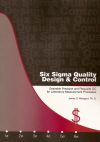Six Sigma
Six Sigma - Designing Quality Control for Neonatal Screening Assays
Newborn screening is an area of testing where test interpretation and treatment guidelines for physicians are published by many laboratories, as well as regulatory agencies. Six Sigma concepts can be applied to these tests, translating the interpretation guidelines into tolerance limits. (Preview)
- An introduction to neonatal screening
- Is neonatal screening different?
- What issues are critical?
- What quality management strategies are important?
- How can Six Sigma quality design and control be implemented?
- An example application: phenylalanine
- References
An Introduction to Neonatal screening
Medical tolerance limits can be defined from test interpretation guidelines that describe a “gray zone” between two values that lead to different medical decisions and treatments. Neonatal screening provides many examples where laboratories actually publish test interpretation and treatment guidelines for the physicians who are responsible for the care of the newborns. Intuitively, Six Sigma concepts should apply here since the whole purpose of such testing is to identify congenital defects that can be treated effectively when detected early. Millions of newborns are being tested. High analytical quality and a low defect rate in the testing processes are essential.
Neonatal screening programs are mandated in many countries and often operate under the auspices of the government. In the US, for example, most neonatal screening is provided through the official health laboratories of the individual states, often called State Public Health Laboratories. These laboratories need to provide high quality, high volume testing, with fast reports, and low costs. While these service requirements are similar to those in hospital clinical laboratories, newborn screening is often considered to be a special category of laboratory testing.
The history of neonatal screening generally begins in the 1960s with screening for phenylketonuria by use of a biological inhibition assay for phenylalanine that was introduced by Guthrie [1]. Screening for congenital hypothyroidism was introduced in the late 1970s by use of a chemical radioimmunoassay measurement of thyroxine. A variety of other microbiological and chemistry tests have expanded the screening applications in the 80s and 90s. At the beginning of the new millennium, tandem mass spectrometry (TMS) is poised to provide a technological revolution in neonatal screening.
 Want to read more of this article?
Want to read more of this article?
We invite you to purchase the Six Sigma QC Design and Control manual, Second Edition, available at our online store. You can also download the Table of Contents and a Sample chapter.
